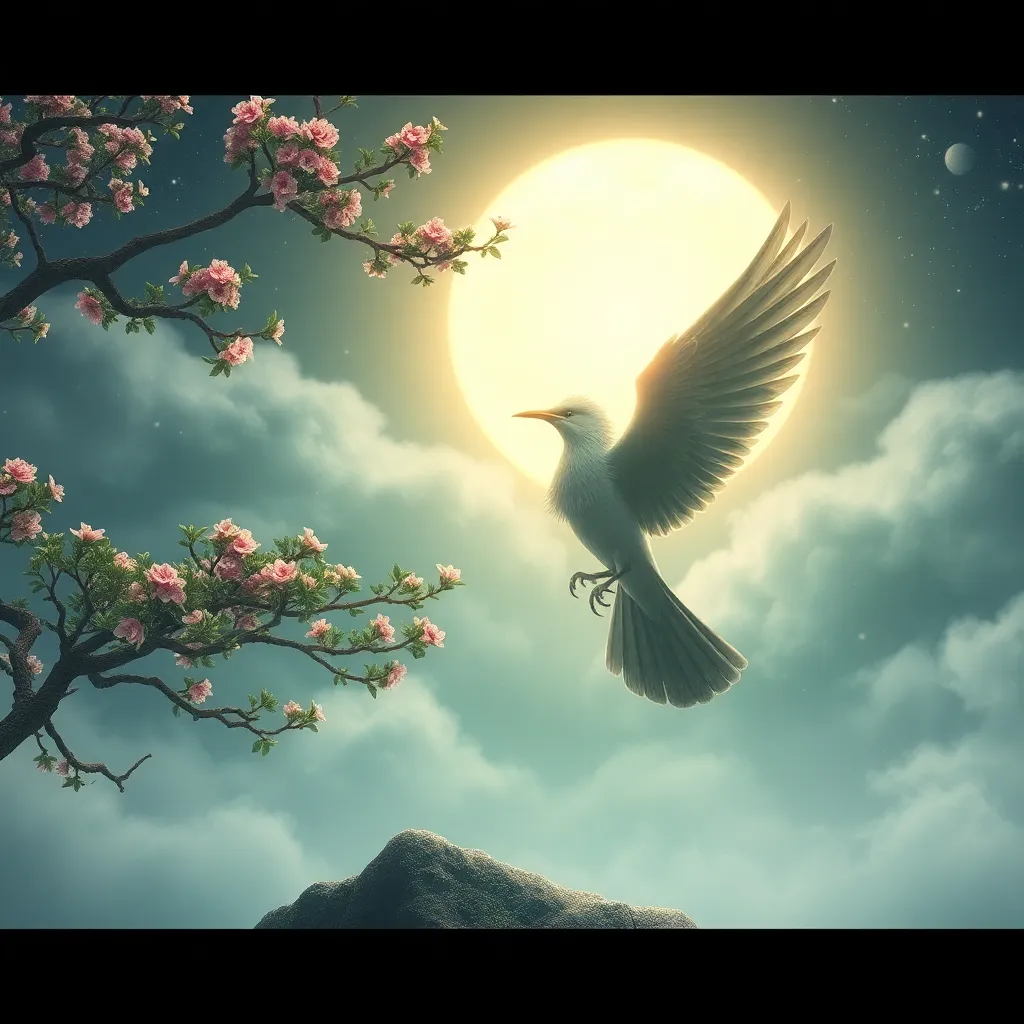The Ho-o Bird’s Song: A Harmony of Nature and Immortality in Japanese Legend
I. Introduction
The Ho-o Bird, often referred to as the Phoenix in Western mythology, holds a significant place in Japanese folklore and cultural identity. This mythical creature embodies beauty, grace, and the essence of nature’s harmony. Its song, considered a celestial melody, is a vital aspect of its legend, symbolizing peace, prosperity, and immortality.
The significance of the Ho-o Bird’s song transcends mere beauty; it serves as a cultural touchstone, representing the connection between the natural world and the spiritual realm. Through its enchanting melodies, the Ho-o Bird inspires reverence and reflection on life, death, and rebirth. This article explores the origins, symbolism, and lasting impact of the Ho-o Bird and its song in Japanese mythology.
II. The Ho-o Bird: Mythical Origins and Symbolism
A. Description of the Ho-o Bird and its characteristics
The Ho-o Bird is often depicted as a majestic creature with vibrant plumage, a long tail, and a graceful neck. Its appearance is reminiscent of various birds but is unique in its ethereal beauty. The Ho-o is adorned with colors that symbolize different virtues, such as:
- Red: Represents vitality and life force.
- Gold: Symbolizes wealth and prosperity.
- Green: Reflects harmony and balance.
B. Historical roots in Japanese folklore
The origins of the Ho-o Bird can be traced back to ancient Chinese mythology, where it was known as the Fenghuang. Over time, it was adopted into Japanese culture, evolving into the Ho-o. In Japanese lore, the bird is often associated with the Empress and is a symbol of grace and virtue. Its presence signifies the arrival of peace and prosperity, making it a revered figure in various narratives.
C. Symbolic meanings associated with the Ho-o Bird
The Ho-o Bird symbolizes a multitude of concepts, including:
- Rebirth and renewal
- Harmony between nature and humanity
- Spiritual enlightenment
- Immortality and eternal life
These meanings contribute to the bird’s revered status in Japanese culture, reinforcing its connection to both nature and the divine.
III. The Song of the Ho-o Bird: A Musical Representation of Nature
A. Description of the bird’s song and its melodic qualities
The song of the Ho-o Bird is described as a harmonious blend of sounds, echoing the beauty of nature. Its melody is often likened to the gentle rustling of leaves, the flowing of water, and the whisper of the wind. This celestial song is believed to evoke feelings of tranquility and joy, resonating deeply within the hearts of those who hear it.
B. Connection between the song and natural elements
The Ho-o Bird’s song is not merely a sound but a representation of the interconnectedness of all living things. Each note embodies the essence of:
- The changing seasons
- The cycle of life and death
- The nurturing power of nature
In this way, the song serves as a reminder of the beauty and fragility of life, urging listeners to appreciate the world around them.
C. Cultural interpretations of the song’s significance
In Japanese culture, the song of the Ho-o Bird is often seen as a harbinger of good fortune and happiness. It is believed that hearing the bird’s song brings blessings, prosperity, and a sense of peace. Traditional ceremonies and festivals may incorporate the bird’s song as a way to honor nature and invoke protection and prosperity.
IV. The Theme of Immortality in Ho-o Bird Legends
A. Exploration of immortality themes in Japanese mythology
Immortality is a prevalent theme in Japanese mythology, often represented through various creatures and deities. The Ho-o Bird stands out as a symbol of eternal life, embodying the belief that life continues beyond death.
B. The Ho-o Bird as a representation of eternal life
In legends, the Ho-o Bird is said to rise from its ashes, much like the Phoenix. This cycle of rebirth signifies that life is an ongoing journey, with death merely a transition to a new beginning. The bird’s song, therefore, becomes a celebration of this eternal cycle.
C. Parallels with other immortality symbols in Japanese culture
Similar to the Ho-o, other symbols such as the crane and the tortoise also represent longevity and immortality in Japanese culture. These creatures, along with the Ho-o Bird, emphasize the importance of living in harmony with nature and the spiritual world.
V. Artistic Representations of the Ho-o Bird’s Song
A. Depictions in traditional Japanese art and literature
The Ho-o Bird has been a muse for countless artists throughout history. In traditional paintings and textiles, the bird is often depicted in flight, surrounded by elements of nature. Literature also captures its essence, with poems and stories celebrating the beauty of its song and its symbolic meanings.
B. Influence on music and performing arts
The enchanting qualities of the Ho-o Bird’s song have inspired numerous musical compositions and performances. Traditional Japanese music often incorporates themes and motifs related to the bird, reflecting its beauty and the harmony of nature.
C. Modern interpretations and adaptations
In contemporary culture, the Ho-o Bird continues to inspire artists, musicians, and writers. Its image and song can be found in modern media, from anime to visual arts, showcasing the ongoing relevance of this mythical creature.
VI. The Ho-o Bird in Contemporary Culture
A. Role in Japanese celebrations and festivals
The Ho-o Bird plays a vital role in various Japanese festivals, where it symbolizes good fortune and prosperity. Celebrations often include performances that honor the bird, emphasizing its importance in cultural heritage.
B. Influence on modern media and pop culture
In recent years, the Ho-o Bird has made its way into popular culture, appearing in video games, anime, and literature. Its story continues to resonate with audiences, reflecting the timeless nature of its message.
C. Ongoing relevance of the Ho-o Bird’s message in today’s society
The themes of peace, harmony, and immortality represented by the Ho-o Bird remain relevant in today’s fast-paced world. As society grapples with environmental issues, the bird’s song serves as a reminder of the importance of preserving nature and fostering a connection with the spiritual world.
VII. The Interplay between Nature and Mythology
A. The Ho-o Bird as a bridge between the natural and spiritual worlds
The Ho-o Bird serves as a bridge connecting the natural world with the spiritual. Its beauty and song remind us of the intricate relationship between humanity and nature, urging individuals to embrace this connection for a harmonious existence.
B. Lessons learned from the harmony of nature and mythology
Through the legends of the Ho-o Bird, we learn valuable lessons about the importance of balance and respect for the environment. The stories encourage us to honor nature’s cycles and appreciate the beauty that surrounds us.
C. Importance of preserving this cultural heritage
As modern society progresses, it is crucial to preserve cultural heritage, including the myths and legends surrounding the Ho-o Bird. These stories not only enrich our understanding of history but also inspire future generations to appreciate the harmony of nature and mythology.
VIII. Conclusion
In conclusion, the Ho-o Bird holds a significant place in Japanese legend, symbolizing beauty, harmony, and immortality. Its song, a melodic representation of nature, resonates deeply within the cultural identity of Japan. The lasting impact of the Ho-o Bird’s song encourages us to appreciate the delicate balance between the natural world and our spiritual beliefs. It serves as a call to protect and nurture the harmony that exists within nature and mythology, ensuring that these timeless stories continue to inspire future generations.




